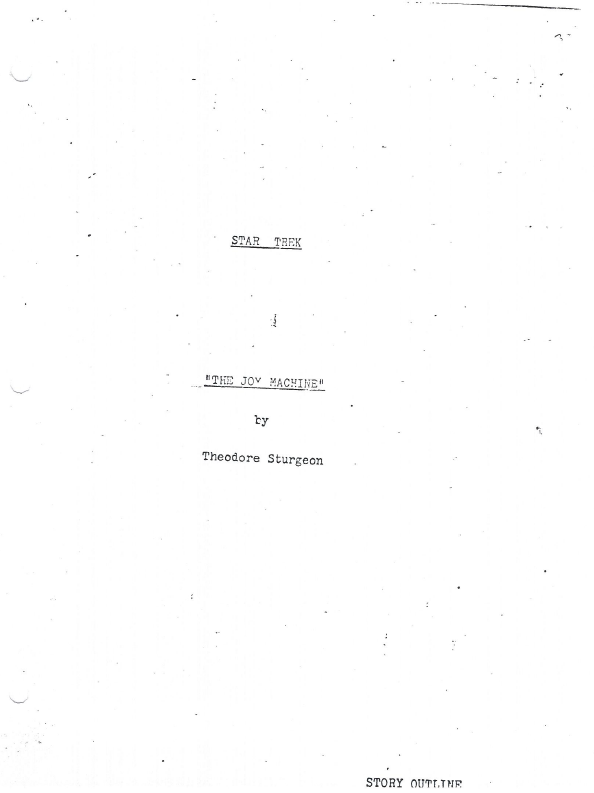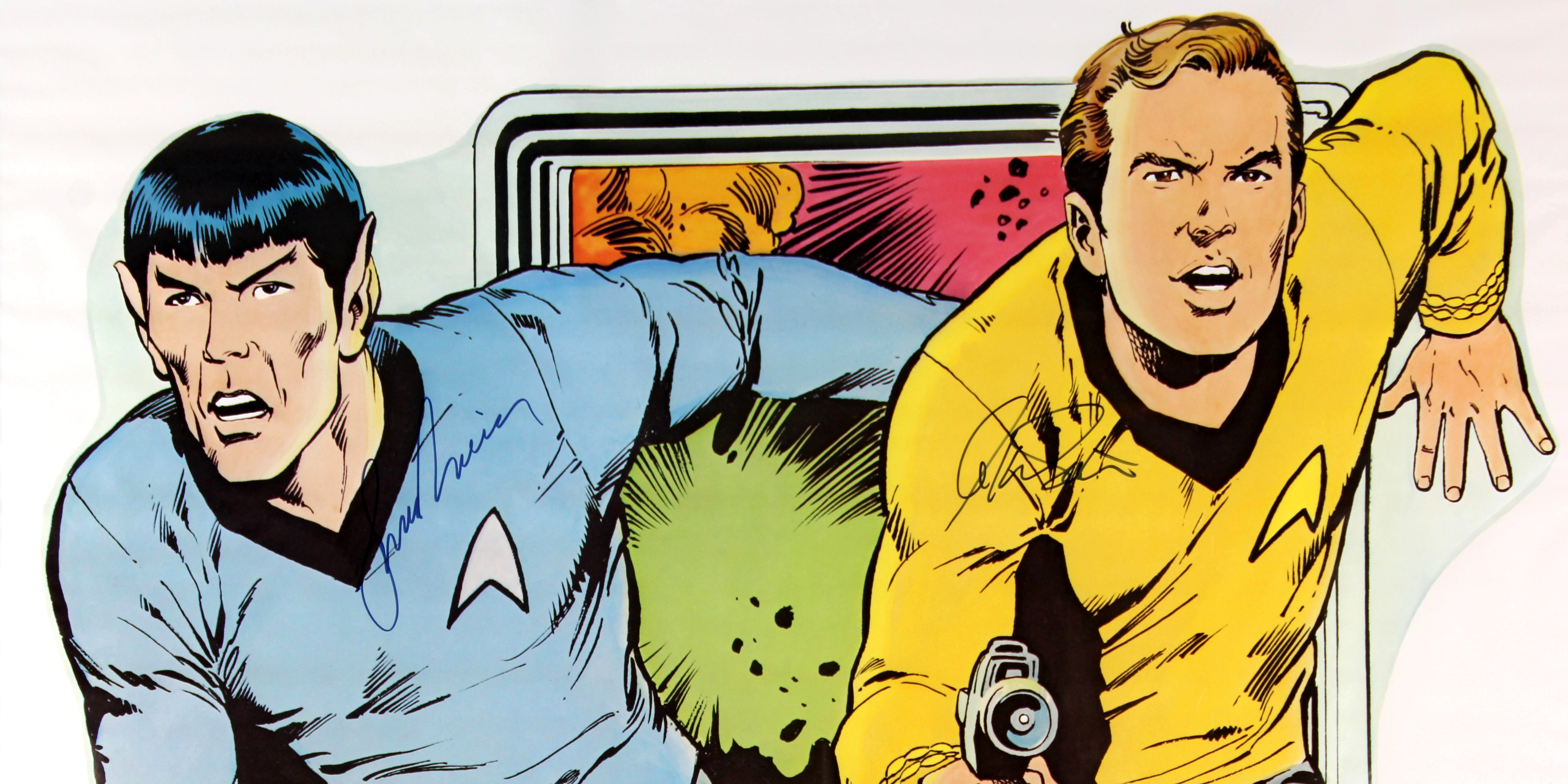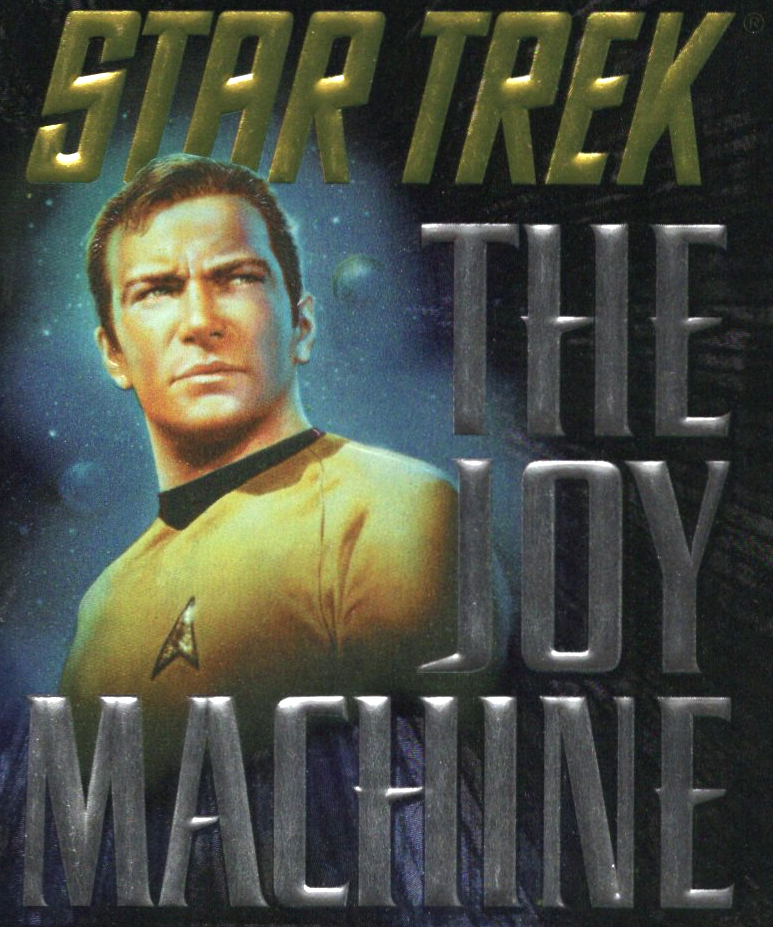Warning: there are plot spoilers below for the novel The Joy Machine.
I have been trying to rediscover the Star Trek novels I loved as a teen. Why only trying? Because, so far, they have not been very good. I have started more than I have finished.
I recently read the novelization of The Joy Machine. It was written by James Gunn, based on a story outline Ted Sturgeon submitted during the second season of Star Trek. I have a copy of that outline and I was curious what Gunn had done with it. (I also own Sturgeon’s outline for Amok Time, from his own typewriter.)


Sadly, the novelization is just not good. To be fair, Sturgeon’s outline was a little weak, too. We’ll start with that.
The Root of Evil
The story was called The Root of Evil in Sturgeon’s first outline. I have not seen it. He delivered a second take on May 16, 1967, retitled The Joy Machine. I have a scan of that document.
The story takes place on Timshel. The planet was considered almost a paradise but cut off all communication with the Federation two years earlier. Kirk is sent to investigate, as he has personal connections to the place: his former fiancée resigned from Starfleet after moving to Timshel and his friend Marouk is an administrator on the planet.
Kirk beams down alone and quickly discovers that the inhabitants are in thrall to the Joy Machine, a computer that rewards menial labour with an electronically induced state of absolute euphoria called a “payday,” delivered through a wristband all adults wear. Planetwide, the citizens have given up ambition, learning and development, and instead sweep streets and build pottery bowls to accumulate enough credits to earn their next fix.


The premise is equal parts The Return of the Archons, with the Joy Machine and payday subbing in for Landru and red hour, and This Side of Paradise, in which the spores create a simple world of subsistence farming in the same way the inhabitants of Timshel pursue mundane tasks. “We’ve done nothing here. No accomplishments, no progress,” Elias Sandoval says when released from the spores, and that describes the residents of Timshel since the advent of payday.
Both of those episodes aired in the first season, long before Sturgeon typed out his story outline. And it is a well Star Trek drew from often; see also The Apple. Sturgeon is clearly commenting on drug addiction more than those other stories did but the basics — a docile and obedient population rewarded with joy or wellbeing — are the same.
Sturgeon’s resolution is interesting, if really implausible. Spock, McCoy and Uhura figure out how to remotely reprogram the un-addicted so that the Joy Machine will not deliver actual joy to them.
…the wave-length, or channel, of the Timshel brain can be shifted, by means of the ‘payday’ machine, to a new frequency that will continue to operate with them, but which will not affect anyone else. This way, the quarter-million ‘incurables’ on the planet can live out their lives just as they are — but to anyone else the device will accomplish nothing but instant sleep. The children would never know: they’d grow up wondering vaguely why their folks enjoyed it so much.

So…250,000 people are to be left to their addiction, and the teens will now have no reason to resign themselves to mindless labour and will therefore rebel at the idea, creating huge — and irreconcilable — conflict with all the adults.
It’s not a great denouement but at least Kirk does not talk the computer to death. In Sturgeon’s outline. Now, on to the novelization.
Gunn’s take
Gunn writes in his novel’s afterword that he considered Sturgeon a mentor and a friend. After Sturgeon’s death in May of 1985, an editor at Pocket Books handed Gunn a copy of the outline and asked him to turn it into a novel.
(Marc Cushman wrote in These Are The Voyages, Season Three, that Sturgeon was paid to turn his outline into a screenplay, and that he delivered the first draft on October 21, 1967, followed by two revisions on November 8 and 13. Gunn, however, specified that he worked from an outline, not a script, and I have never seen Sturgeon’s full script.)
Gunn took on the challenge.
Page one of the novel sets the scene: “Timshel turned slowly in its orbit, a blue-and-white oasis in a dark desert of desolation, an exquisite anomaly in the lifeless void.” We are also told that “The citizens of Timshel were in love with each other, in love with the universe, in love with life. Being there, if only for a few weeks or a few days, or even a few hours, was like being reborn.”
And that is the first problem here: that overblown tone continues throughout. The second problem is basic sentence structure. We have bits like “The right side of the room was walled off into small rooms” and “The next morning he felt a small shiver run through the ship as he sat at the ship’s second sitting for breakfast.” This is careless writing or lack of editing, or both. One more: “He found a screwdriver, a pair of wire cutters, and an infinitely adjustable wrench…” Even putting aside the impossibility that its adjustments are infinite, just say “an adjustable wrench.”
These examples illustrate why the adult me has trouble enjoying Star Trek novels: they often come across as products produced quickly, with little regard for quality.
About half of Gunn’s pages are devoted to a band of rebels who live in the arctic. They do not appear in Sturgeon’s outline. I understand the need to stretch the story to novel length, but ideally new content would contribute to character development, tension, or the outcome. Instead, the insurgents are entirely inconsequential; their chapters could be yanked out with no change to the outcome.
Landru. Nomad. Norman. The M-5
While Sturgeon’s brain reprogramming was a stretch, it was at least inventive. Gunn’s story ends with Kirk talking a computer to death, as he had done already in three episodes at the time the outline was written and was about to do again in The Ultimate Computer.
Kirk encountered the Joy Machine early on as a smallish box sitting alone in a room. Towards the end of the story, he and a few others walk into a multi-denominational chapel in the capital city and find “alcoves containing figures or symbolic representations.” These religious statues come to life to debate with the crew. How does this happen, and why? That’s never addressed. It comes across as essentially magic.
The first is a Buddha which “opened its eyes and spoke to them.” They discuss the nature of pleasure, and McCoy makes the first speech. “People are meant to pursue happiness, not to perpetually achieve it.”
The next niche holds an elaborate three-part statue representing Brahma, Vishnu and Siva, and “an exotic incense drifted around the figures and into the air.” One of the figures comes to life, changing into “a naked black woman with four arms wearing a garland composed of the heads of giants. Around her neck was a string of skulls.” (How does a human-sized statue wear a number of giants’ heads? Good question.)
Uhura decides to play the woman card, for some reason. “I am a woman, and I speak to you as a woman… As a woman, I know that the proper way to raise children is with kindness. But it is not kind to give children everything they want. Then they never grow up.”
They next approach the figure of Apollo, who “stretched his hand toward Spock as if trying to pass along the spark of truth.”
Lastly, they encounter the Joy Machine back in its basic form of a small box. It also speaks to them, and it is now Kirk’s turn to hold forth. “Happiness is not the only good,” the captain says. “Humans value other things even more: love, friendship, accomplishments, discovery, and, most of all, knowledge. Given a free choice between happiness and knowledge, humanity will choose knowledge every time.”
Sound familiar? It’s the story of Adam and Eve through a lens of This Side of Paradise. In case you missed that, Kirk mentions a Bible story about paradise and the Joy Machine replies “The Garden of Eden.” And that seemingly does the trick.
“Happiness is seductive, but it is ephemeral. Knowledge is eternal. Give your people free will. Provide only the guidelines that an omnipotent being can offer without making its people mere puppets.”
The Joy Machine sat silent for what seemed like minutes to Kirk and the others, but may have been only moments.
The bracelets on the wrists of four of them sprang open and fell to the floor.
And that’s it. Wristbands litter the ground and all the citizens of Timshel may now continue as they were meant to, embracing unhappiness in the quest for knowledge.
These two tropes — Kirk kills a computer and suffering and striving are essential to the human condition — were used in the series more often than was ideal but that is understandable when a small group of people are pumping out 24 to 29 episodes per season on a tight budget. In a novel, however, the use of these fallbacks is just disappointing.
There is also the disturbing reality that the crew encounters and moves past representations of many religions but the challenge of the Joy Machine is only solved when Christian mythology is referenced. I cannot say if that Christian-centric view was intentional but surely someone at Pocket Books should have called out this seeming endorsement of one belief system over others.
Both the novel and the outline sidestep the criticism leveled at episodes such as The Apple, in which Kirk arguably breaks his oath through a quick decision to entirely change a planet’s culture. Timshel is a member of the Federation and at least some of its citizens want help. But this does share the same somewhat unsatisfactory feeling that Kirk lands, dislikes what he sees, changes everything, and then just warps away.
Sturgeon first pitched The Joy Machine for season two and, after revisions, it was added to the list for season three. Marc Cushman writes that it was planned as the 25th episode of that season, and that William Shatner was slated to direct. The third season of TOS contained only 24 episodes.
I don’t love Sturgeon’s outline but it was better than Gunn’s take, and it would have been interesting to see Shatner direct a Star Trek story. Instead, we had to wait 20 years for Star Trek V.
Postscript
James Gunn wrote 16 novels and that is 16 more than I have penned, but I really have no respect for the mechanics of his writing. Here is another bit: “The bridge was once more solidly under Kirk’s feet. He felt the characteristic resilience of its floor beneath him.”

Resilience means “the capacity to recover” or “an ability to spring back into shape.” And even if we accept that the intention was to be evocative rather than literal, surely describing a deck first as solid and then as resilient is redundant.
I am currently reading Child of Two Worlds by Greg Cox. It is set aboard Captain Pike’s Enterprise and, so far, it is quite good.


2 responses to “Review: The Joy Machine story outline and novel”
Never, ever, ever trust Marc Cushman. You cite him in this piece saying there was an October 21, 1967 draft by Sturgeon. This is incorrect. Strugeon turned in his drafts in November 1967. Dissatisfied, Robert Justman set the story aside and suggested revisiting the script with another writer in season 3. This was done and Meyer Dolinsky’s 3rd season draft was dated October 21, 1968. You can read all about the history here: https://whatculture.com/tv/10-star-trek-the-original-series-episodes-that-were-almost-made?page=5
My advice would be to deep-six the Cushman books. They are filled with so many mistakes they are rendered worthless.
LikeLike
[…] Collectingtrek.ca has added a new review for James Gunn‘s “Star Trek: 80 The Joy Machine”: […]
LikeLike